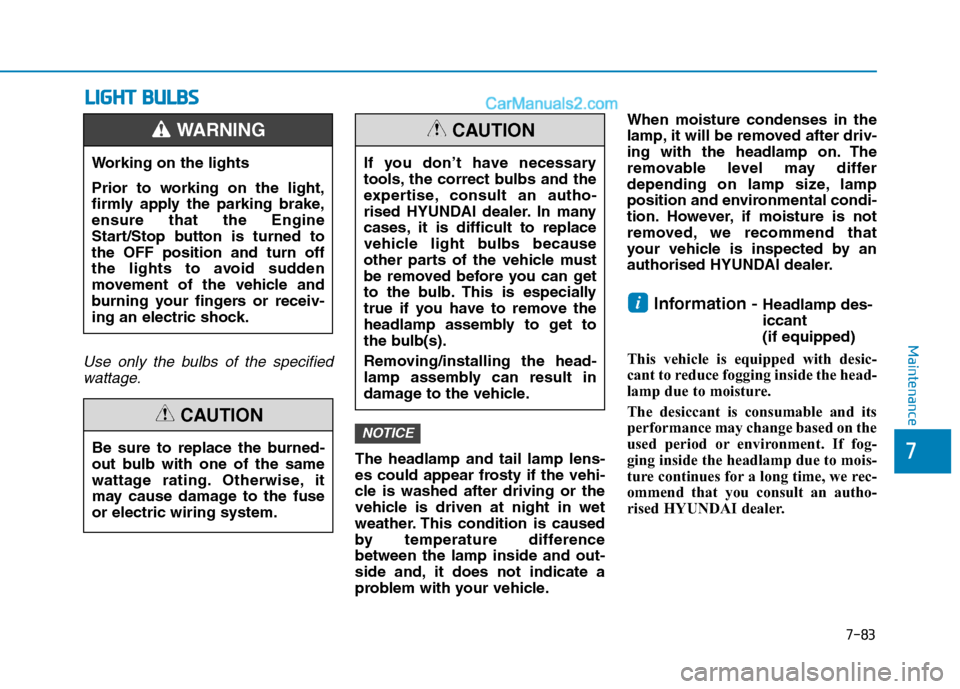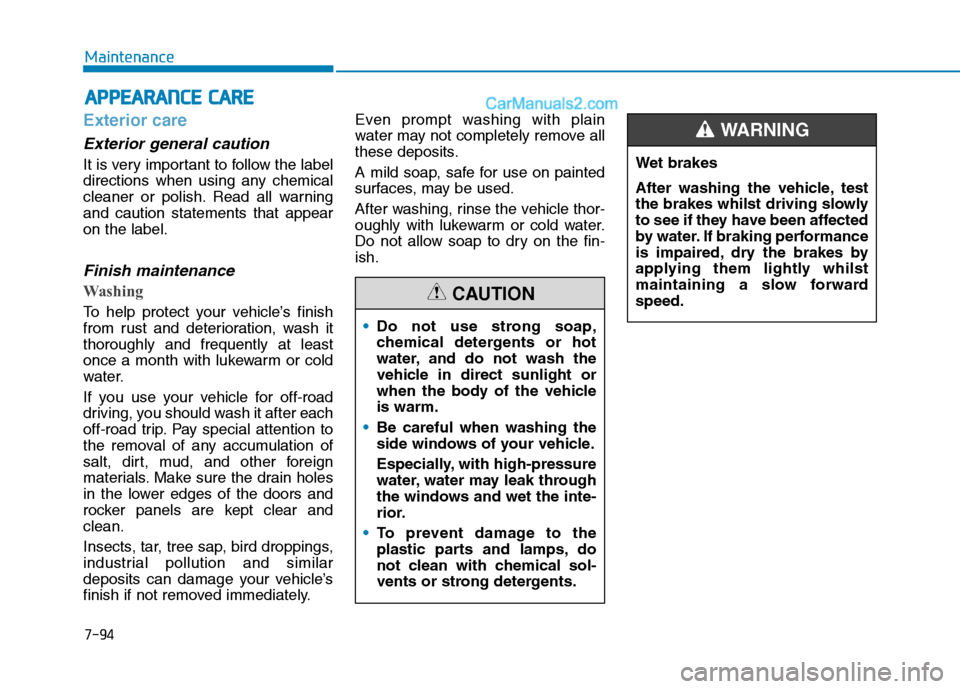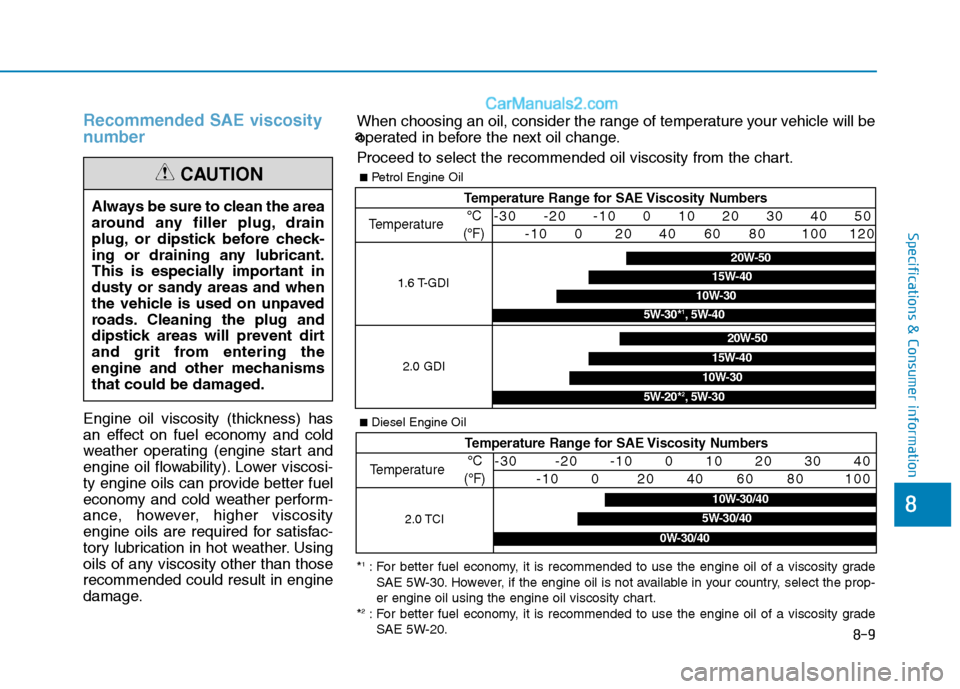Page 599 of 637

7-83
7
Maintenance
L LI
IG
GH
HT
T
B
BU
UL
LB
BS
S
Use only the bulbs of the specified
wattage.
The headlamp and tail lamp lens-
es could appear frosty if the vehi-
cle is washed after driving or the
vehicle is driven at night in wet
weather. This condition is caused
by temperature difference
between the lamp inside and out-
side and, it does not indicate a
problem with your vehicle.When moisture condenses in the
lamp, it will be removed after driv-
ing with the headlamp on. The
removable level may differ
depending on lamp size, lamp
position and environmental condi-
tion. However, if moisture is not
removed, we recommend that
your vehicle is inspected by an
authorised HYUNDAI dealer.
Information - Headlamp des-
iccant
(if equipped)
This vehicle is equipped with desic-
cant to reduce fogging inside the head-
lamp due to moisture.
The desiccant is consumable and its
performance may change based on the
used period or environment. If fog-
ging inside the headlamp due to mois-
ture continues for a long time, we rec-
ommend that you consult an autho-
rised HYUNDAI dealer.i
NOTICEBe sure to replace the burned-
out bulb with one of the same
wattage rating. Otherwise, it
may cause damage to the fuse
or electric wiring system.
CAUTION
If you don’t have necessary
tools, the correct bulbs and the
expertise, consult an autho-
rised HYUNDAI dealer. In many
cases, it is difficult to replace
vehicle light bulbs because
other parts of the vehicle must
be removed before you can get
to the bulb. This is especially
true if you have to remove the
headlamp assembly to get to
the bulb(s).
Removing/installing the head-
lamp assembly can result in
damage to the vehicle.
CAUTION
Working on the lights
Prior to working on the light,
firmly apply the parking brake,
ensure that the Engine
Start/Stop button is turned to
the OFF position and turn off
the lights to avoid sudden
movement of the vehicle and
burning your fingers or receiv-
ing an electric shock.
WARNING
Page 610 of 637

7-94
Maintenance
A AP
PP
PE
EA
AR
RA
AN
NC
CE
E
C
CA
AR
RE
E
Exterior care
Exterior general caution
It is very important to follow the label
directions when using any chemical
cleaner or polish. Read all warning
and caution statements that appear
on the label.
Finish maintenance
Washing
To help protect your vehicle’s finish
from rust and deterioration, wash it
thoroughly and frequently at least
once a month with lukewarm or cold
water.
If you use your vehicle for off-road
driving, you should wash it after each
off-road trip. Pay special attention to
the removal of any accumulation of
salt, dirt, mud, and other foreign
materials. Make sure the drain holes
in the lower edges of the doors and
rocker panels are kept clear and
clean.
Insects, tar, tree sap, bird droppings,
industrial pollution and similar
deposits can damage your vehicle’s
finish if not removed immediately.Even prompt washing with plain
water may not completely remove all
these deposits.
A mild soap, safe for use on painted
surfaces, may be used.
After washing, rinse the vehicle thor-
oughly with lukewarm or cold water.
Do not allow soap to dry on the fin-
ish.
Do not use strong soap,
chemical detergents or hot
water, and do not wash the
vehicle in direct sunlight or
when the body of the vehicle
is warm.
Be careful when washing the
side windows of your vehicle.
Especially, with high-pressure
water, water may leak through
the windows and wet the inte-
rior.
To prevent damage to the
plastic parts and lamps, do
not clean with chemical sol-
vents or strong detergents.
CAUTION
Wet brakes
After washing the vehicle, test
the brakes whilst driving slowly
to see if they have been affected
by water. If braking performance
is impaired, dry the brakes by
applying them lightly whilst
maintaining a slow forward
speed.
WARNING
Page 633 of 637

8-9
8
Specifications & Consumer information
Recommended SAE viscosity
number
Engine oil viscosity (thickness) has
an effect on fuel economy and cold
weather operating (engine start and
engine oil flowability). Lower viscosi-
ty engine oils can provide better fuel
economy and cold weather perform-
ance, however, higher viscosity
engine oils are required for satisfac-
tory lubrication in hot weather. Using
oils of any viscosity other than those
recommended could result in engine
damage.a
Always be sure to clean the area
around any filler plug, drain
plug, or dipstick before check-
ing or draining any lubricant.
This is especially important in
dusty or sandy areas and when
the vehicle is used on unpaved
roads. Cleaning the plug and
dipstick areas will prevent dirt
and grit from entering the
engine and other mechanisms
that could be damaged.
CAUTION
When choosing an oil, consider the range of temperature your vehicle will be
operated in before the next oil change.
Proceed to select the recommended oil viscosity from the chart.
*1: For better fuel economy, it is recommended to use the engine oil of a viscosity grade
SAE 5W-30. However, if the engine oil is not available in your country, select the prop-
er engine oil using the engine oil viscosity chart.
*
2: For better fuel economy, it is recommended to use the engine oil of a viscosity grade
SAE 5W-20.
Temperature Range for SAE Viscosity Numbers
Temperature°C
(°F)-30 -20 -10 0 10 20 30 40 50
-10 0 20 40 60 80 100 120
2.0 GDI
20W-50
10W-30
15W-40
5W-20*2, 5W-30
20W-50
15W-40
10W-30
5W-30*1, 5W-40
1.6 T-GDI
■Petrol Engine Oil
■Diesel Engine Oil
Temperature Range for SAE Viscosity Numbers
Temperature°C
(°F)-30 -20 -10 0 10 20 30 40
-10 0 20 40 60 80 100
5W-30/40
10W-30/40
0W-30/40
2.0 TCI